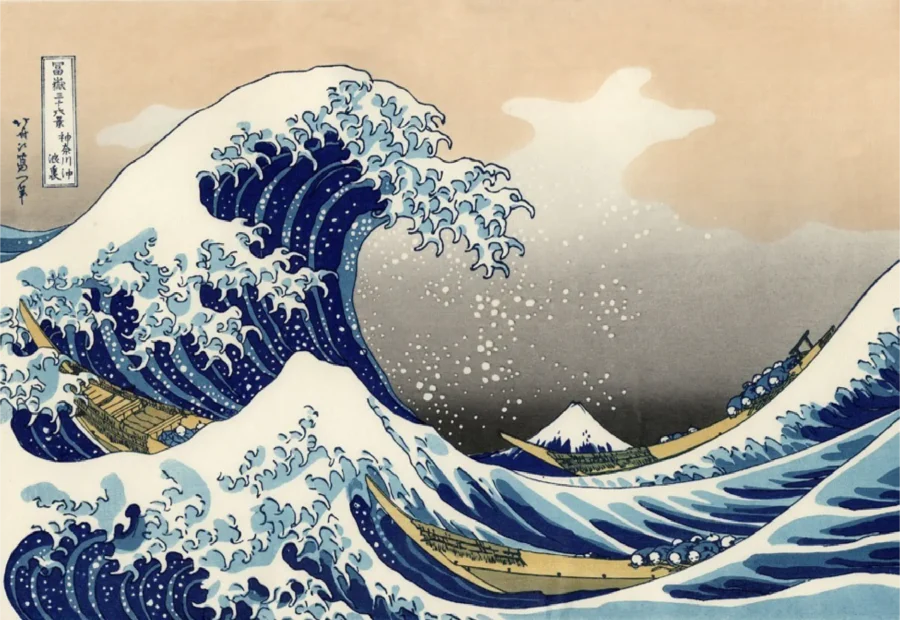A cultural sensation is on the horizon for the summer of 2025 in the United States: The Cleve Carney Museum of Art (CCMA) in Glen Ellyn, Illinois, will present the exhibition “Hokusai and Ukiyo-e: The Floating World, Artworks from the Chiossone Collection” from May 31 to September 21, 2025. This show marks the first presentation of a significant collection of 53 paintings and woodblock prints, as well as 13 historical artifacts from the Museo d’Arte Orientale E. Chiossone in Genoa, Italy, on American soil. At its heart are nine original works by the iconic Katsushika Hokusai, including his world-famous masterpiece “The Great Wave off Kanagawa,” as well as 17 works by Utagawa Hiroshige and pieces by 15 of their contemporaries.
The exhibition promises to be far more than a traditional art show; it aims to take visitors on an immersive journey into the culture and lifestyle of Japan from the 17th to the 19th centuries. The realization of this ambitious project, in collaboration with the renowned Genoese museum and the international exhibition organizer MondoMostre, not only underscores cultural diplomacy but also positions the museum in the Chicago metropolitan area as a major player on the national stage for art events of this magnitude. The choice of the summer period also suggests an expectation of attracting a broad audience, including tourists, and making the show a cultural focal point.

The ‘Floating World’, A Journey into Japan’s Edo Period
The term ‘Ukiyo-e,’ literally translated as ‘pictures of the floating world,’ refers to an art movement that flourished during Japan’s Edo period (1603–1868). Originally, the term ‘Ukiyo’ was rooted in the Buddhist understanding of a ‘transient, sorrowful world.’ However, during the Edo period—an era of prolonged peace, economic prosperity, and progressive urbanization under the Tokugawa Shogunate—its meaning transformed. It began to encompass the fleeting pleasures and vibrant urban culture, with the character for ‘sorrowful’ being replaced by that for ‘to float’ or ‘to drift.’ This semantic shift reflects a profound cultural transformation in which a society, freed from constant warfare and buoyed by urban prosperity, developed a new appreciation for the worldly pleasures of the moment. Ukiyo-e became the artistic expression of this new way of life.
Edo, modern-day Tokyo, developed into the undisputed cultural and economic center of Japan. In this metropolis, a new bourgeois culture of townspeople (Chonin) thrived, seeking their pleasures in Kabuki theaters, sumo arenas, and licensed entertainment districts like Yoshiwara. The themes of Ukiyo-e were diverse, reflecting this urban life: depictions of everyday life, portraits of beautiful women (Bijin-ga), representations of famous Kabuki actors (Yakusha-e) and sumo wrestlers, scenes from history and folk legends, as well as landscapes (Fūkei-ga) and nature depictions, particularly bird-and-flower pictures (Kachō-ga). Surimono, luxurious privately commissioned prints, and Musha-e, warrior depictions, were also part of the repertoire. Even Shunga, erotic art, was a significant and often humorous subgenre that depicted sexuality as part of everyday life and was appreciated by both men and women.
The production of Ukiyo-e prints was a collaborative process requiring the skills of an artist (designer), a wood carver, a printer, and a publisher. Publishers like Tsutaya Jūzaburō played a key role in discovering and promoting talent and marketing the works. Woodblock printing technology, especially multi-color printing (Nishiki-e, ‘brocade pictures’), enabled mass production, making art affordable for a broad public for the first time. This contrasted with earlier art forms reserved for an elite class. Ukiyo-e prints functioned as a popular medium, comparable to today’s posters or magazines, reflecting urban tastes, advertising entertainment, and sometimes offering social commentary.
The collaborative, artisanal production underscores that Ukiyo-e was both an art form and an industry responding to market demand, where publishers often dictated themes a departure from the Western Romantic ideal of the solitary artistic genius. The Utagawa school, for example, operated more like a “printing and advertising company.”
Japan’s relative isolation during the Edo period (Sakoku) was crucial for the unique development of Ukiyo-e. Although the country was not hermetically sealed trade with the Dutch in Nagasaki allowed limited Western influences, such as the introduction of Prussian blue to the color palette this seclusion fostered a distinctly Japanese aesthetic. It was precisely this autonomy and fresh perspective that fascinated the West when Japan reopened in the 19th century, and Ukiyo-e art began its global triumph.
Masters of the Moment, Hokusai, Hiroshige, and Contemporaries
At the center of the exhibition are two giants of Ukiyo-e: Katsushika Hokusai and Utagawa Hiroshige. Katsushika Hokusai (ca. 1760–1849), born Tokitarō in Edo, trained as a wood carver before becoming a student of the Ukiyo-e master Katsukawa Shunshō. He was a restless spirit who explored various styles, including European techniques, and worked under numerous names. His oeuvre comprises over 30,000 works. Hokusai is considered a key figure in expanding Ukiyo-e themes from courtesans and actors to landscapes, plants, and animals.
He introduced European perspectives and compositional techniques into Japanese printmaking, thereby modernizing traditional styles. His most famous work, “The Great Wave off Kanagawa” from the series “36 Views of Mount Fuji,” will be on display at the exhibition, alongside eight other originals. His renowned “Hokusai Manga,” sketchbooks displaying an encyclopedic variety of motifs, also contributed to his fame. Hokusai was also a master of self-promotion, increasing his notoriety through public art performances, such as painting a giant Daruma portrait.
Utagawa Hiroshige (1797–1858), born Andō Tokutarō in Edo, came from a samurai family and later joined the school of Utagawa Toyohiro. He is famous for his tranquil and poetic landscape compositions as well as his bird-and-flower pictures (Kachō-ga). Hiroshige mastered the depiction of atmosphere and weather phenomena of snow, rain, fog and often harmoniously integrated human figures into his landscapes, lending his works a particular intimacy. His style is often described as more romantic and subtle compared to Hokusai’s boldness. The exhibition will feature 17 works by Hiroshige, who became known primarily through series like “The 53 Stations of the Tōkaidō” and “One Hundred Famous Views of Edo.”
The juxtaposition of these two masters in the exhibition offers a fascinating opportunity to grasp the breadth of Ukiyo-e landscape art. While Hokusai was a bold innovator who pushed boundaries, Hiroshige excelled in the lyrical capture of moods. Alongside these two luminaries, the show presents works by 15 of their contemporaries, including a depiction of the actor Nakamura Nakazō II by Utagawa Kunimasa. The inclusion of these other artists is crucial for demonstrating the breadth and collaborative nature of the Ukiyo-e world. It attests to the existence of various schools, such as the dominant Utagawa school , and specializations in genres like Bijin-ga or Yakusha-e.
This moves away from a sole focus on individual “great masters” and illuminates Ukiyo-e as a vibrant artistic ecosystem. Also noteworthy is Hokusai’s use of the term “Manga” for his sketchbooks , a direct historical link to contemporary Japanese manga art, which is honored in the exhibition with its own interactive section on the history of manga and anime. This connection bridges centuries of Japanese visual narrative art and makes the historical works particularly accessible to a younger audience.

A Treasure from Genoa, The Lasting Legacy of Edoardo Chiossone
The collection traveling to Glen Ellyn originates from the Museo d’Arte Orientale E. Chiossone in Genoa and is inextricably linked to Edoardo Chiossone (1833–1898). Chiossone, an Italian engraver, painter, and art collector, was invited to Japan by the Meiji government in 1875 to work in the Ministry of Finance’s printing workshop. There, he played a significant role in designing Japan’s first modern banknotes, postage stamps, and government bonds, thus contributing substantially to the modernization of the Japanese financial system during the Meiji Restoration (1868–1912).
During his approximately 23-year stay in Japan, Chiossone amassed an extraordinary collection of Japanese art, including paintings, prints, sculptures, lacquerware, bronzes, and armor—totaling over 15,000 objects. He collected during a period of upheaval, as Japan rapidly modernized and opened to Western influences, and traditional artworks became more readily available on the antiques market. His collection is renowned for its high quality, diversity, and the remarkable state of preservation of the works. Chiossone bequeathed his treasures to the Ligurian Academy of Fine Arts in Genoa with the stipulation that they be made accessible to the public. The Museo d’Arte Orientale E. Chiossone, founded in 1905, was the first museum of Japanese art in Italy and houses one of the most significant collections of its kind in Europe.
The loan of these works to the CCMA for their U.S. debut is a significant event, made possible through the collaboration between the CCMA, the Chiossone Museum, and the support of MondoMostre, a leading international exhibition producer. Edoardo Chiossone was more than just a passive collector; as a Western expert, he was actively involved in Japan’s modernization. His collection can therefore be seen as a bridge between two cultures at a historical turning point, reflecting both his European connoisseurship and his deep engagement with Japan. The fact that Chiossone, an agent of Westernization in finance, simultaneously became a preserver of traditional Japanese art, lends the collection an additional historical dimension. It was formed during a phase when Japan itself was grappling with Western influence and the value of its own cultural heritage.
The loan of such a significant and excellently preserved collection underscores the trust and strong institutional relationships between the participating museums and organizations. It attests to successful cultural diplomacy and the global recognition of the Chiossone collection’s importance, whose protection and presentation are facilitated by official agreements such as the U.S. Department of State’s “Notice of Determinations; Culturally Significant Objects Being Imported for Exhibition.”
More Than Just Pictures, An Immersive Cultural Experience at the CCMA
The exhibition “Hokusai and Ukiyo-e: The Floating World” at the Cleve Carney Museum of Art spans over 10,000 square feet and is designed to be much more than a conventional museum presentation. The goal is to immerse visitors deeply in the culture of the Edo period through a variety of interactive and multisensory exhibits created exclusively for the CCMA and the McAninch Arts Center (MAC). Highlights include a historical area explaining the context of Edo and Ukiyo-e, as well as “Hokusai’s World: Step into Edo,” a walk-through replica of an Edo-era shopping street with a bookstore and traditional row house (Nagaya). A special feature is the “Immersive History of Manga & Anime,” a hand-drawn environment designed by the team from Chicago’s renowned 2d Restaurant, Vanessa Vu and Kevin Yu, which traces the evolution from Hokusai’s sketches to modern anime like “Demon Slayer.”
Outdoors, the “Great Wave Garden,” a Japanese-inspired garden with real plants, a bridge, and a picnic area, invites visitors to linger. For younger visitors, there is a dedicated children’s area (“Hokusai Kids Area”) with discovery opportunities like calligraphy and origami. In the “Ukiyo-e Imagination Station,” visitors can design their own prints, and a “Samurai & Silk Selfie Station” offers the chance to be photographed in shogun and kabuki costumes. Culinary offerings in the Edo-period style (“Edo EATS!”) and a gift shop with Hokusai-inspired items complete the experience.
Accompanying the main exhibition is the public art project “Waves of DuPage.” In collaboration with Naperville artist Richard Lo, Ukiyo-e-inspired depictions of landmarks from around 18 DuPage County communities, including Glen Ellyn, Naperville, and Villa Park, are being created. These over 30 site-specific, large-format vinyl murals will be installed in their respective communities, while original prints will be shown in the Hokusai exhibition. This project aims to foster local identity, attract visitors, and extend the exhibition’s impact beyond the museum walls. An extensive supporting program with unveilings of the public artworks, a mini-Japan art expo, and Shodō calligraphy workshops complements the show.
The extensive use of interactive elements signals a strategic direction for the CCMA to increase the appeal of historical art to a broad audience, including families, and to create an “experience” rather than just an “exhibition.” The “Waves of DuPage” project, in turn, promotes local participation and anchors the historical art form in a regional context. The collaboration with the 2d Restaurant team for the manga/anime section is a clever move to incorporate contemporary design expertise for immersive, social-media-friendly environments, thereby further enhancing the quality of the experience.
Expert Opinions, Curatorial Insights and Artistic Resonance
Leading figures from the museum and external experts underscore the exhibition’s importance. Diana Martinez, Director of the McAninch Arts Center (MAC) and Executive Director of the exhibition, emphasizes that the show is “so much more than just ‘The Great Wave’” and offers a “rich, multisensory Edo experience across 25,000 square feet.” She anticipates “hundreds of thousands of visitors from around the world” and highlights the interactive elements designed to bring visitors closer to the era of shoguns, samurai, and geishas. Justin Witte, Curator of the CCMA, points to the massive influence of Japanese art from this period on Western art and culture, known as Japonisme. He states: “The distinctive and graphic style of these images still feels fresh and innovative today, inspiring contemporary artists like Takashi Murakami and Hayao Miyazaki, as well as creators of manga and anime.” Witte is curating the part of the exhibition at the CCMA that displays the Chiossone collection. The presentation of the loans from the Chiossone Museum is curated by Professor Rossella Menegazzo from the University of Milan, a distinguished art historian, which underscores the exhibition’s scholarly depth.
The art of Ukiyo-e, particularly the works of Hokusai and Hiroshige, exerted a profound influence on Western artists in the late 19th century. Impressionists and Post-Impressionists such as Monet, Degas, Van Gogh, and Cassatt were inspired by the compositions, perspectives, color schemes, and everyday subjects of Ukiyo-e. Van Gogh, for example, directly copied prints by Hiroshige. This influence, known as Japonisme, also extended to Art Nouveau and other design fields. Witte’s curatorial framing of the exhibition, which deliberately bridges historical Ukiyo-e art and contemporary Japanese visual culture, aims to enhance its relevance for a broader and younger audience.
The collaboration between an American curator and an Italian art historian for an exhibition of Japanese art from an Italian collection in the USA illustrates a globalized approach in art history and museum practice, bringing together diverse scholarly perspectives. The emphasis on Japonisme not only serves art historical education but also validates the importance of Ukiyo-e by highlighting its impact on celebrated Western masters, which can make Japanese art more accessible to a Western audience primarily familiar with European art history.
The Sustainable Impact of the ‘Floating World’, Expectations and Future Prospects
The exhibition “Hokusai and Ukiyo-e: The Floating World” promises to be a key cultural event for the Chicago metropolitan area and beyond, attracting a considerable number of visitors. It offers a unique educational opportunity to learn more about Japanese art, the culture of the Edo period, and the complex production process of Ukiyo-e prints. The immersive design aims to leave a lasting impression and provide a deeper understanding than traditional exhibitions. The accompanying “Waves of DuPage” project will strengthen local community spirit and promote appreciation for public art.
Furthermore, the exhibition acts as a cultural exchange between the USA, Italy, and Japan, demonstrating art’s power to connect cultures and inspire a global audience. The official recognition of the loan’s cultural significance by the U.S. Department of State underscores this aspect. For the CCMA itself, the show builds on its reputation for realizing ambitious large-scale exhibitions, such as those on Frida Kahlo and Andy Warhol, and could further sharpen the profile of the museum and the College of DuPage as a cultural destination. There is potential to sustainably foster interest in Japanese art and culture in the USA. The careful handling and presentation of these delicate, light-sensitive woodcuts will also testify to the museum’s high professional standards.
This exhibition could serve as a model for how regional or university-affiliated museums can create world-class cultural events with local and national appeal through international partnerships and innovative exhibition design. The focus on the “Experience Economy” in museum practice, which this show exemplarily embodies, reflects a broader trend in how cultural institutions attempt to reach their audiences in an increasingly competitive attention landscape. The success of this exhibition could further validate this approach. Finally, the American presentation might reignite international interest in the Chiossone collection itself, leading to further research, publications, or future international loans from this significant, though perhaps less globally known, repository of Japanese art.
#Hokusai2025 #Ukiyoe #TheGreatWave #JapaneseArt #FloatingWorld #CCMAExhibition #Hokusai #Hiroshige #MangaHistory #ImmersiveArt









